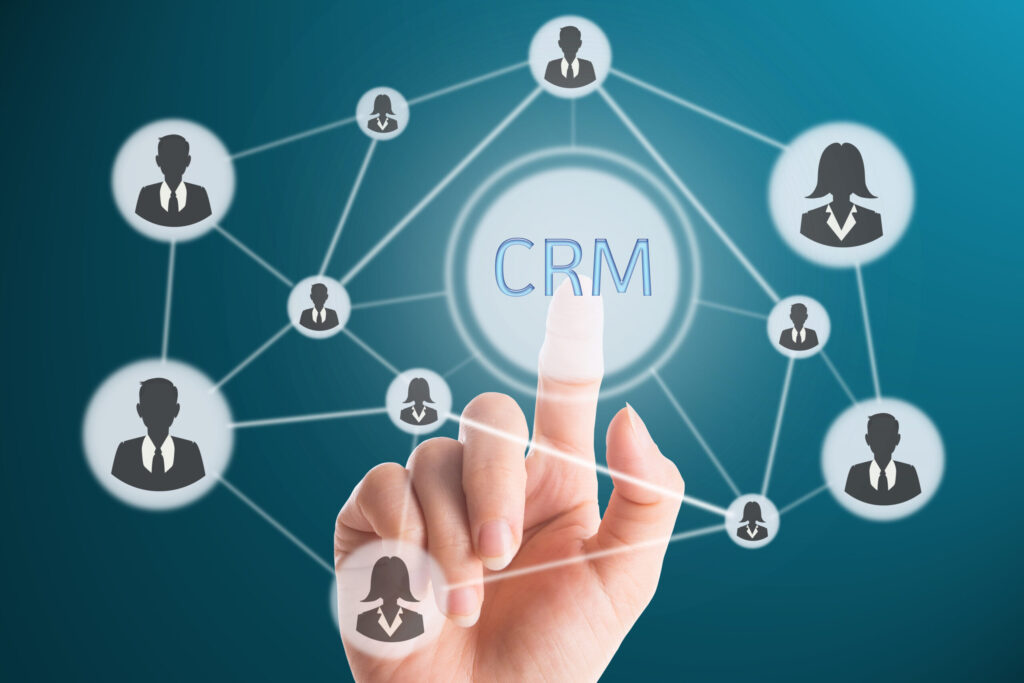Welcome, business owners and entrepreneurs! Building strong customer relationships is the key to success in today’s competitive market. And that’s where Customer Relationship Management (CRM) comes into play.
CRM, or Customer Relationship Management, refers to a set of strategies, processes, and technologies that help businesses manage their interactions with customers. It involves using specialized software systems to streamline various aspects of customer interactions, such as sales leads, marketing campaigns, and customer service.
CRM systems streamline and automate various customer-related processes, saving time and effort. With a well-implemented CRM system, you can efficiently manage customer interactions, track sales leads, and enhance customer satisfaction.
So, let’s explore the benefits of CRM in more detail and how you can harness its power to take your business to new heights.
Customer Relationship Management (CRM) refers to the strategies, processes, and technologies implemented by businesses to effectively manage and nurture their relationships with customers. It involves collecting and analyzing customer data to gain valuable insights and develop personalized interactions. CRM systems serve as a central hub for organizing customer information, enabling businesses to provide better customer service, streamline sales processes, and enhance overall customer satisfaction.
Implementing CRM systems aims to optimize customer interactions and improve business outcomes. By centralizing customer data, businesses can gain a comprehensive view of their customers, which enables them to make informed decisions and tailor their marketing, sales, and customer service efforts accordingly. The benefits of implementing CRM systems are numerous:
Enhanced customer engagement:
CRM systems provide businesses with a deeper understanding of their customers’ needs, preferences, and behaviors. This knowledge allows businesses to deliver personalized experiences, build stronger relationships, and increase customer loyalty.
Streamlined sales processes:
CRM systems enable businesses to track sales leads, automate sales workflows, and manage the sales pipeline more efficiently. Sales teams can prioritize leads, forecast sales, and identify cross-selling or upselling opportunities, resulting in increased revenue and improved conversion rates.
Improved customer service:
CRM systems allow businesses to track and manage customer interactions across multiple channels, such as phone, email, social media, and live chat. This ensures consistent and efficient customer support, as customer service representatives have access to relevant customer information, history, and preferences, enabling them to resolve issues promptly and provide personalized assistance.
Data-driven decision-making:
CRM systems capture and analyze customer data, providing businesses valuable insights into customer behavior, market trends, and sales performance. These insights enable businesses to make data-driven decisions, develop targeted marketing campaigns, identify areas for improvement, and adapt their strategies to meet customer needs effectively.
CRM is crucial in managing customer interactions effectively by providing a holistic view of customers across all touchpoints. Here’s how CRM helps in this aspect:
Centralized customer data:
CRM systems consolidate customer information from various sources into a single, unified database. This centralized view allows businesses to access comprehensive customer profiles, including contact details, purchase history, interactions, and preferences. This readily available data enables businesses to personalize interactions and deliver more relevant and timely communications.
Automated customer tracking:
CRM systems automate capturing and tracking customer interactions across different channels. This includes recording phone calls, tracking email communications, monitoring social media interactions, and documenting live chat conversations. By capturing these interactions, businesses can better understand their customers’ needs, preferences, and pain points, enabling them to respond appropriately and provide a seamless experience.
Integrated communication channels:
CRM systems facilitate the integration of various communication channels, allowing businesses to engage with customers through their preferred means of communication. Whether it’s email, phone, social media, or live chat, CRM systems enable businesses to consolidate all customer interactions into a single interface, ensuring a consistent and cohesive experience across channels.
Task and activity management:
CRM systems provide task and activity management features, allowing businesses to assign and track customer-related tasks among team members. This ensures that all customer inquiries, requests, and follow-ups are handled efficiently and promptly, minimizing the risk of oversight or miscommunication.
CRM systems are vital in tracking sales leads and increasing conversion rates. Here’s how CRM facilitates this process:
Lead capturing and qualification:
CRM systems enable businesses to capture leads from various sources, such as website forms, social media campaigns, and offline events. Once captured, leads are automatically recorded in the CRM database, allowing businesses to assess and qualify their potential. CRM systems often provide lead scoring functionality, which assigns a numerical value to leads based on predefined criteria, helping sales teams prioritize their efforts on high-value leads.
Sales pipeline management:
CRM systems visually represent the sales pipeline, allowing businesses to track the progress of leads through various stages, from initial contact to closing the deal. This visibility enables sales teams to identify bottlenecks, forecast sales, and allocate resources effectively. Sales managers can assess the pipeline’s health, identify potential gaps, and proactively address any issues.
CRM systems allow sales teams to log and track their activities related to each lead or opportunity. This includes recording phone calls, meetings, emails, and other touchpoints. By tracking these activities, businesses gain insight into the sales process, identify areas for improvement, and ensure consistent follow-up with leads. This level of visibility helps sales teams stay organized, prioritize tasks, and maximize their efficiency in converting leads into customers.
CRM systems provide analytics and reporting features that offer valuable insights into sales performance. Sales managers can analyze conversion rates, win/loss ratios, average deal sizes, and other key metrics to identify patterns, trends, and areas for improvement. By leveraging this data, businesses can refine their sales strategies, optimize sales processes, and increase conversion rates.
Customer satisfaction is paramount for businesses as it directly impacts customer loyalty, brand reputation, and long-term profitability. CRM systems play a pivotal role in enhancing customer satisfaction in the following ways:
Personalized experiences:
CRM systems enable businesses to understand individual customer preferences, purchase history, and communication preferences. With this knowledge, businesses can tailor their interactions to provide personalized experiences. Personalization builds rapport, fosters trust, and demonstrates that the business values its customers, ultimately leading to higher customer satisfaction.
Efficient issue resolution:
CRM systems empower customer service representatives by comprehensively viewing each customer’s interaction history, previous inquiries, and reported issues. With this information, customer service teams can quickly address customer concerns, resolve issues promptly, and provide effective solutions. This efficient issue resolution leads to greater customer satisfaction and loyalty.
Proactive customer engagement:
CRM systems enable businesses to set up automated workflows and triggers based on predefined customer events or milestones. For example, businesses can automate personalized follow-up emails after a purchase, send relevant product recommendations, or notify customers about upcoming renewals or upgrades. These proactive engagements demonstrate attentiveness, show that the business values its customers, and contribute to an enhanced customer experience.
CRM systems facilitate customer feedback collection and enable businesses to track and analyze customer satisfaction metrics. By monitoring customer satisfaction scores, businesses can identify areas of improvement and take proactive measures to address any shortcomings. Regularly measuring customer satisfaction and acting upon feedback demonstrates a commitment to quality and helps businesses continually enhance their products, services, and overall customer experience.
A CRM system is essential for businesses seeking to manage customer interactions effectively, track sales leads, and enhance customer satisfaction. CRM systems provide a holistic view of customers, streamline sales processes, facilitate personalized interactions, and enable businesses to make data-driven decisions. By leveraging CRM systems, businesses can forge stronger customer relationships, increase conversion rates, and achieve sustainable growth in today’s competitive business landscape.
Customer data management is a crucial aspect of CRM systems that helps businesses build strong and lasting customer relationships. Companies gain valuable insights into their customers’ preferences, behaviors, and needs by collecting and organizing customer data. This enables businesses to provide personalized experiences, improve customer satisfaction, and drive growth.
The significance of collecting and organizing customer data
Collecting and organizing customer data allows businesses to understand their customers more deeply. It helps identify patterns and trends, enabling businesses to tailor their marketing strategies and product offerings accordingly. Companies can deliver targeted and relevant communications by having a comprehensive view of customer information, resulting in higher engagement and conversion rates.
Various methods for capturing customer information
There are multiple methods for capturing customer information. These include:
Online forms and registrations: Websites and landing pages can have forms that customers fill out to provide their contact details, preferences, and interests.
Surveys and feedback: Conducting surveys or requesting feedback allows businesses to gather specific information directly from customers.
Social media monitoring: Monitoring social media platforms helps capture customer sentiments, preferences, and interactions.
Purchase history and transactions: Tracking customer purchases and interactions with the business provides valuable insights into their preferences and behaviors.
The importance of maintaining accurate and up-to-date customer records
Accurate and up-to-date customer records are essential for effective CRM. By maintaining accurate records, businesses can ensure that customer communications are relevant and timely. Outdated or incorrect information can lead to miscommunication and missed opportunities. Regularly updating customer records also allows businesses to track changes in customer preferences and adapt their strategies accordingly.
CRM systems offer powerful features and functionalities for managing sales leads, enabling businesses to optimize their sales processes and drive revenue growth.
Features and functionalities of CRM systems for managing sales leads
CRM systems provide a centralized platform for capturing, tracking, and managing sales leads. These systems typically offer:
Lead capture and qualification:
CRM systems enable businesses to capture and qualify leads from various sources based on predefined criteria.
Lead assignment and tracking:
Leads can be assigned to specific sales representatives, who can track their interactions and progress through the sales pipeline.
CRM systems help businesses manage sales opportunities by tracking stages, activities, and associated revenue.
Forecasting and reporting:
CRM systems provide insights into sales performance, allowing businesses to forecast revenue and generate sales reports.
Lead tracking, follow-up activities, and pipeline management
CRM systems facilitate lead tracking by recording all customer interactions, including calls, emails, and meetings. This helps sales teams stay organized and follow up on leads promptly. The pipeline management feature in CRM systems allows businesses to visualize and manage the sales process, ensuring that opportunities are not lost or forgotten.
Benefits of automation in sales processes through CRM
Automation plays a vital role in enhancing sales processes through CRM systems. By automating routine tasks such as lead assignment, follow-up reminders, and data entry, businesses can save time and increase productivity. Automation also reduces the chances of human error, ensures consistent follow-up, and enables sales teams to focus on building relationships and closing deals.
CRM systems offer valuable tools for improving customer service and support, leading to enhanced customer satisfaction and loyalty.
How CRM can improve customer service and support
CRM systems enable businesses to provide personalized and efficient customer service by centralizing customer information and interactions. With access to a customer’s history, preferences, and previous support tickets, customer service representatives can provide a more tailored and informed experience. CRM systems also facilitate faster response times, better issue tracking, and proactive support, resulting in improved customer satisfaction.
Features such as ticketing systems, knowledge bases, and customer portals
CRM systems often include ticketing systems, knowledge bases, and customer portals to enhance customer service and support. Ticketing systems enable businesses to efficiently track and manage customer inquiries, ensuring timely resolution. Knowledge bases provide self-service options, empowering customers to find answers to common questions. Customer portals offer a centralized platform for customers to access their account information, submit support requests, and access relevant resources
The importance of personalized and efficient customer support
Personalized and efficient customer support is crucial for building strong customer relationships. By addressing customer queries promptly and accurately, businesses demonstrate their commitment to customer satisfaction. Personalization in support interactions, such as addressing customers by name and understanding their unique needs, helps create a positive and memorable experience. Efficient support processes enabled by CRM systems lead to faster issue resolution and, ultimately, higher customer loyalty.
CRM systems provide valuable analytics and reporting capabilities that empower businesses to make data-driven decisions and improve their performance.
The role of Analytics in CRM Systems
Analytics in CRM systems involves analyzing customer data to gain insights into customer behavior, preferences, and trends. These insights help businesses identify opportunities, measure the effectiveness of marketing campaigns, and optimize their strategies. By leveraging analytics, businesses can understand their customers better and make informed decisions to drive growth.
How CRM can provide valuable insights into customer behavior and trends
CRM systems collect and analyze customer data, enabling businesses to identify patterns and trends. These insights can include customer demographics, purchase histories, engagement levels, and preferences. By understanding customer behavior and trends, businesses can tailor their marketing efforts, product offerings, and customer experiences to meet evolving demands, ultimately improving customer satisfaction and loyalty
Benefits of data-driven decision-making through CRM analytics
Data-driven decision-making through CRM analytics offers several benefits. By leveraging insights from customer data, businesses can:
Identify cross-selling and upselling opportunities to increase revenue.
Let’s discuss the importance of aligning CRM system features with your business goals. Your CRM should address current needs and support your long-term objectives.
By aligning the CRM features with your business goals, you can ensure that the system helps you achieve specific outcomes. For example, if your goal is to improve customer satisfaction, your CRM system should include features like customer service ticketing and personalized communication options.
When selecting a CRM system, it’s essential to understand the different types available. There are cloud-based CRM systems hosted on the internet and on-premises CRM systems installed locally on your company’s servers. Cloud-based systems offer flexibility and accessibility, while on-premises systems provide more control over data and customization.
Consider your business requirements, budget, and IT infrastructure to determine which type of CRM system suits you best.
Let’s discuss key factors to consider when choosing a CRM system.
Ensure that the CRM system can accommodate your business’s growth. It should be able to handle increasing data volumes and user demands without compromising performance.
Look for a CRM system that seamlessly integrates with your existing tools and software, such as email clients, marketing automation platforms, and accounting software. Integration eliminates data silos and enables smooth information flow across departments.
pt for a CRM system that is intuitive and user-friendly. It should require minimal training and be easily adopted by your employees.
Evaluating CRM vendors and their offerings is a crucial step. Here are some tips to help you make an informed decision:
Thoroughly research CRM vendors and compare their products. Look for customer reviews, case studies, and testimonials to gauge their reputation and performance
Check if the CRM system allows customization according to your specific business needs. Customization empowers you to tailor the system to your unique processes and workflows.
Assess the vendor’s customer support options, including documentation, online resources, and responsive help desks. Additionally, inquire about their system updates and upgrades to ensure continuous improvement.
Audience: Now, let’s discuss the steps involved in implementing a CRM system. This process typically includes:
Define your implementation goals, allocate necessary resources, and create a timeline for the implementation process. Set clear objectives for each stage to monitor progress effectively.
Ensure a smooth transfer of your existing customer data into the CRM system. It’s crucial to maintain data accuracy and integrity during the migration process.
Integrate the CRM system with other business applications, such as email, marketing, and customer support tools. This integration enables seamless data flow and improves overall efficiency.
CRM systems often provide customization options to align the system with your business processes. Customization can include modifying data fields, creating new reports, or designing personalized workflows.
Take advantage of these customization options to tailor the CRM system to your needs. This will enable your team to work more efficiently and derive maximum value from the system.
Training your employees on effectively using the CRM system is crucial for its successful implementation. Provide comprehensive training programs that cover the system’s features, functionalities, and best practices. Training will empower your employees to leverage the CRM system to its full potential, improving customer interactions and sales management.
Promoting user adoption and overcoming resistance to change are common challenges when implementing a CRM system. Here are some tips to address these concerns:
Obtain buy-in from your leadership team and communicate the benefits of the CRM system to all employees. Employees who see their leaders endorsing the system are more likely to embrace it.
b. Continuous Communication:
Keep your team informed about the implementation process, training sessions, and system updates. Address any concerns or questions promptly to maintain transparency and build trust
c. Incentives and Rewards:
Recognize and reward employees who actively engage with the CRM system. Incentives can motivate reluctant users and reinforce the importance of utilizing the system effectively.
Assessing business needs, choosing the right CRM system, implementing and customizing it, and focusing on training and adoption are crucial steps in successfully managing customer interactions, tracking sales leads, and enhancing customer satisfaction through CRM implementation.
Improved Customer Satisfaction and Loyalty:
By centralizing customer data and interactions, a CRM system empowers businesses to provide personalized and timely customer service. With a 360-degree view of customer interactions, preferences, and purchase history, businesses can tailor their offerings and communication to individual needs. This level of personalization enhances customer satisfaction, strengthens relationships, and fosters long-term loyalty.
Increased Sales and Conversion Rates:
A CRM system enables businesses to manage sales leads and opportunities effectively. By tracking prospects, nurturing relationships, and prioritizing sales efforts, sales teams can improve their effectiveness and conversion rates. Moreover, CRM systems provide valuable insights into customer behavior, allowing businesses to identify cross-selling and upselling opportunities and increase sales revenue.
Enhanced Efficiency and Productivity:
Implementing a CRM system streamlines and automates various business processes, increasing efficiency and productivity. With automated workflows and standardized processes, employees can focus on value-added activities rather than repetitive administrative tasks. A CRM system also eliminates the need for manual data entry and reduces the chances of errors, ensuring data accuracy and consistency.
Key Performance Indicators (KPIs) to Track:
To measure the ROI of a CRM implementation, businesses can monitor key performance indicators related to customer satisfaction, sales performance, and productivity. KPIs include customer satisfaction scores, customer retention rates, sales revenue, sales conversion rates, average deal size, and employee productivity metrics. By tracking these KPIs over time, businesses can evaluate the impact of the CRM system on their bottom line
Cost Savings and Revenue Growth:
CRM systems can generate significant cost savings by eliminating manual processes, reducing administrative overhead, and improving operational efficiency. Businesses can measure cost savings by comparing pre-and post-implementation costs related to sales, customer service, and marketing activities. Additionally, revenue growth resulting from increased sales, improved customer retention, and enhanced cross-selling opportunities can contribute to the overall ROI.
Long-term Value and Competitive Advantage:
CRM systems offer long-term value beyond immediate financial gains. By building stronger customer relationships, businesses can foster customer loyalty and reduce customer churn. Leveraging customer data for targeted marketing campaigns and personalized communication further strengthens a company’s competitive advantage. Furthermore, a CRM system provides valuable insights into customer preferences, market trends, and emerging opportunities, enabling businesses to adapt and innovate proactively.
In today’s competitive business landscape, nurturing strong relationships with customers is of utmost importance, and a well-implemented CRM system can be the key to achieving this. Businesses can provide personalized experiences, timely responses, and tailored solutions by managing customer interactions. Furthermore, tracking sales leads enables businesses to identify promising opportunities, prioritize them, and convert them into valuable customers. Ultimately, these efforts enhance customer satisfaction, increasing loyalty and advocacy. Implementing a CRM system offers numerous benefits, such as improved efficiency, streamlined processes, enhanced collaboration, and valuable insights for strategic decision-making. If you haven’t explored CRM solutions, now is the perfect time to take action. Investing in a CRM system can gain a competitive edge and unlock new growth opportunities. Don’t hesitate to reach out for further engagement or consultation. Let’s embark on this CRM journey together!





